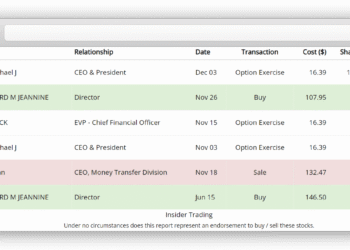The Dollar Index, often abbreviated as DXY, has recently experienced significant fluctuations, falling by -0.52% to hit a new two-month low. This decline has been exacerbated by a disappointing US retail sales report, which revealed a steep drop of -0.9%, well below the anticipated -0.2%. Furthermore, with the 10-year T-note yield also decreasing, the outlook for the dollar remains uncertain amidst rising concerns over a potential global trade war. As tariffs loom, particularly on automobiles, investors are closely monitoring the impact on currency pairs, including the EUR/USD trend. Additionally, the precious metals outlook appears tied to the dollar’s movements, as market sentiments shift in response to economic indicators and geopolitical tensions.
The DXY, or Dollar Index, serves as a vital barometer for the strength of the US dollar against a basket of major currencies. Recent economic data, particularly the latest US retail sales figures, have raised eyebrows among analysts, leading to a reevaluation of the dollar’s performance in the global market. Additionally, the ongoing tensions from a potential trade war and its implications on international relations have sparked discussions about currency stability. As traders assess the EUR/USD trends and the overall economic landscape, the outlook for precious metals remains closely linked to fluctuations in the dollar’s value. Understanding these dynamics is crucial for anyone engaged in currency trading or investing in commodities.
Impact of the Dollar Index on US Economic Indicators
The recent decline in the Dollar Index (DXY) has raised concerns about its implications for various economic indicators in the United States. As the DXY fell by 0.52%, it highlighted the challenges facing the US economy, particularly reflected in the disappointing retail sales report for January. The unexpected -0.9% drop in retail sales, which was significantly worse than the anticipated -0.2%, signals a potential slowdown in consumer spending—a critical driver of economic growth. This downward trend in the dollar’s value could further complicate the economic landscape, especially if it continues to correlate with weak economic data.
Additionally, the decline in the dollar index can influence international trade dynamics, particularly in light of the ongoing global trade war. With the dollar strengthening or weakening, import and export prices fluctuate, affecting competitiveness in the global market. The recent tariff announcements from the Trump administration add another layer of complexity, as tariffs on imports could pressure the dollar further, affecting trade balances and ultimately influencing the broader economy.
Analyzing the US Retail Sales Report
The January retail sales report presented a stark reality for the US economy, showing a decline that was unexpected by analysts. Excluding automobiles, the retail sales dropped by -0.4%, failing to meet the forecast of a slight increase of +0.3%. This data raises questions regarding consumer confidence and spending patterns, particularly as the market grapples with external pressures such as inflation and geopolitical tensions. The wildfires and severe weather conditions also played a role in dampening retail activity, indicating that environmental factors can significantly impact economic performance.
Moreover, the control group retail sales, which are often used to gauge underlying consumer trends, fell by -0.8%. This suggests that the decline is not merely a seasonal fluctuation but could indicate more systemic issues within the economy. The implications of a weaker retail environment could extend beyond immediate consumption, potentially leading to adjustments in monetary policy as the Federal Reserve assesses the need for intervention to stimulate growth.
EUR/USD Trend and Its Market Significance
The EUR/USD currency pair has shown resilience with a +0.28% increase, reflecting a complex interplay of factors affecting both the euro and the dollar. The euro’s ascent is largely attributed to optimistic sentiments surrounding ongoing negotiations related to the Russian-Ukraine conflict. However, this optimism is tempered by the potential impact of new tariffs on US imports from Europe, which could strain the Eurozone economy. As such, traders are closely monitoring these developments to gauge their potential impact on the EUR/USD trend.
Moreover, the Eurozone’s Q4 GDP growth of +0.1% quarter-over-quarter aligns with expectations, but below-par employment growth signals caution. The market’s anticipation of a -25 basis point rate cut by the European Central Bank further complicates the outlook for the euro. As both currencies face external pressures, market participants must remain vigilant to how these factors might shift the balance in the EUR/USD exchange rate, influencing broader market sentiment.
Global Trade War and Currency Fluctuations
The intensification of the global trade war has significant implications for currency fluctuations, particularly for the dollar index. President Trump’s announcement of impending tariffs on automobiles has heightened uncertainty in the markets, leading to speculation about a potential slowdown in growth. As the dollar weakens in response to these trade tensions, it impacts the purchasing power of American consumers and businesses, which could lead to a broader economic slowdown.
The repercussions of this trade war extend beyond the US, threatening global economic stability. Countries heavily rely on trade relationships, and tariffs could disrupt these interactions, pushing currencies into volatility. As the dollar index reacts to these developments, traders must consider how fluctuations in currency values can influence global trade balances and economic policies worldwide.
Precious Metals Outlook Amid Dollar Weakness
The recent decline in the dollar index has led to increased interest in precious metals, particularly gold and silver. As the dollar weakens, precious metals typically gain appeal as a safe-haven asset, prompting a surge in investment. However, April gold closed down -1.52%, reflecting some profit-taking after a strong rally over the previous months. Market dynamics suggest that while a weaker dollar generally boosts gold prices, other factors, such as geopolitical tensions and inflation rates, play significant roles in shaping the outlook for precious metals.
Silver, on the other hand, has shown resilience, with a slight increase amidst the dollar’s decline. The interplay between precious metals and the dollar index highlights how investor sentiment shifts in response to economic indicators. Moving forward, investors will need to assess both macroeconomic conditions and the dollar’s trajectory to make informed decisions regarding their precious metals investments.
US Industrial Production Trends and Economic Implications
US industrial production has shown a slight increase of +0.5% month-over-month, exceeding expectations but accompanied by a decline in manufacturing production. This dichotomy raises questions about the sustainability of industrial growth, especially as manufacturing activities are critical to economic health. The mixed signals from industrial production suggest that while some sectors are performing well, others may be lagging, which could complicate the Federal Reserve’s policy decisions in the near future.
The relationship between industrial production and the dollar index is crucial, as a strong manufacturing sector often supports a solid dollar. However, with January manufacturing production declining by -0.1%, there is increased risk that the dollar may weaken further, affecting international trade competitiveness. As the Federal Reserve evaluates these trends, the interplay between industrial production and currency strength will likely influence future monetary policy adjustments.
Market Expectations for the Upcoming FOMC Meeting
As the markets prepare for the upcoming Federal Open Market Committee (FOMC) meeting on March 18-19, expectations are building regarding potential changes in interest rates. Current market pricing indicates a minimal chance of a -25 basis point cut, as economic indicators like retail sales and industrial production provide mixed signals. However, if the dollar index continues to decline amid persistently weak economic data, the pressure on the Federal Reserve to act may increase.
The decision-making process for the FOMC is complex, as it must balance economic growth with inflationary pressures and external factors like the global trade war. Market participants will be closely monitoring the Fed’s statements and any potential shifts in policy direction, as these decisions can significantly impact the dollar index and overall economic sentiment.
The Role of Tariffs in Currency Valuation
Tariffs play a crucial role in currency valuation, particularly in the context of the ongoing global trade war. The announcement of new tariffs on US imports from Europe could lead to a depreciation of the dollar index, as increased costs for imported goods may strain consumer spending. As the market assesses the implications of these tariffs, traders will likely respond by adjusting their currency positions, potentially leading to increased volatility in the forex markets.
Additionally, the potential retaliatory measures from European countries could exacerbate the situation, further impacting currency values. This dynamic highlights the interconnectedness of trade policy and currency valuation, as shifts in tariffs can lead to significant adjustments in the dollar’s strength. Investors must remain vigilant to how these developments unfold, as they could have far-reaching implications for both the dollar index and broader economic conditions.
Geopolitical Factors Influencing Currency Markets
Geopolitical tensions have a profound impact on currency markets, particularly as seen in the recent fluctuations of the dollar index. The ongoing conflict in Ukraine and its potential implications for European stability play a significant role in shaping investor sentiment. As tensions escalate, currencies may react sharply, with safe-haven assets becoming more appealing amidst uncertainty. The dollar’s performance can be directly influenced by these geopolitical developments, and traders must stay informed about the evolving landscape.
Moreover, the fallout from geopolitical events can lead to shifts in trade dynamics, further affecting currency valuations. As countries navigate the complexities of international relations and trade agreements, currencies may experience volatility that reflects these underlying tensions. Understanding the broader geopolitical context is essential for investors looking to navigate the currency markets successfully.
Frequently Asked Questions
What factors influenced the recent decline in the Dollar Index (DXY)?
The recent decline in the Dollar Index (DXY) was primarily influenced by a weak US retail sales report, which showed a decline of -0.9% in January, worse than the expected -0.2%. Additionally, the -5 basis point drop in the 10-year T-note yield and concerns about a global trade war following President Trump’s tariff announcements also contributed to the DXY’s fall.
How do US retail sales reports impact the Dollar Index (DXY) analysis?
US retail sales reports are crucial for Dollar Index (DXY) analysis as they provide insights into consumer spending, a key component of the US economy. Weak retail sales, like the -0.9% decline reported for January, can lead to a depreciation of the dollar, negatively impacting the DXY as investors anticipate potential Federal Reserve rate cuts.
What is the relationship between the EUR/USD trend and the Dollar Index (DXY)?
The EUR/USD trend is inversely related to the Dollar Index (DXY); when the euro strengthens against the dollar, the DXY typically declines. Recently, the EUR/USD pair rose by +0.28%, partly due to geopolitical factors and expectations of monetary policy changes, which further pressured the DXY downward.
How does a global trade war affect the Dollar Index (DXY)?
A global trade war can negatively affect the Dollar Index (DXY) by creating uncertainty in international trade, leading to a weaker dollar as investors seek safety in other currencies. Recent tariff announcements by the Trump administration have heightened concerns about a trade war, contributing to the DXY’s decline.
What is the outlook for precious metals in relation to the Dollar Index (DXY)?
The outlook for precious metals is often positively correlated with a weaker Dollar Index (DXY). As the DXY falls, precious metals like gold and silver tend to rise, driven by increased demand as investors look for safe-haven assets. Recent market movements showed gold prices declining, despite a weaker dollar, due to long liquidation pressure.
| Key Points | Details |
|---|---|
| Dollar Index Movement | The dollar index (DXY00) fell by -0.52% on Friday, marking a new 2-month low. |
| Retail Sales Report | January retail sales decreased by -0.9%, worse than the expected -0.2%. |
| Industrial Production | US industrial production increased by +0.5% month-over-month, exceeding expectations. |
| EUR/USD Pair Movement | EUR/USD rose by +0.28%, supported by hopes of resolving the Russian-Ukraine conflict. |
| Market Expectations | Markets are pricing in a 2% chance of a -25 basis point rate cut at the upcoming FOMC meeting. |
| Precious Metals Prices | Gold closed down -1.52% while silver increased by +0.39%, influenced by weaker dollar. |
Summary
The Dollar Index has shown significant volatility recently, falling to a 2-month low amidst disappointing retail sales data and ongoing trade war concerns. This decline reflects broader economic challenges that could impact future currency movements, making it crucial for investors to monitor upcoming economic reports and geopolitical developments.













